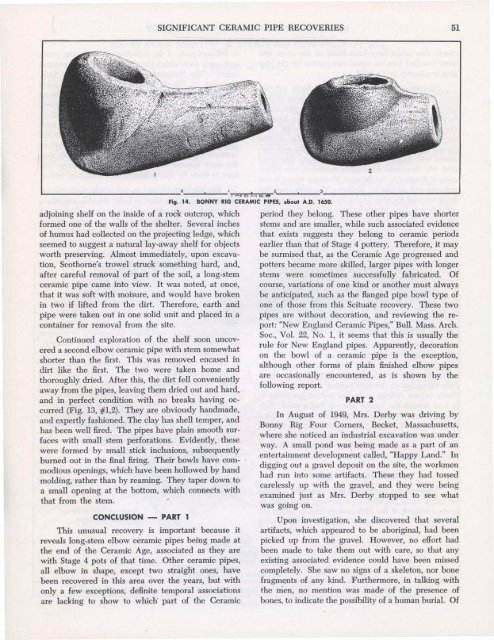An Impelling Force in Research (Editorial), 26(3-4)
An Impelling Force in Research (Editorial), 26(3-4)
An Impelling Force in Research (Editorial), 26(3-4)
Create successful ePaper yourself
Turn your PDF publications into a flip-book with our unique Google optimized e-Paper software.
SIGNIFICANT CERAMIC PIPE RECOVERIES 51<br />
L- --........-- i '"" E :.... .. '" :(:...-_-"-_-'3 --'<br />
adjo<strong>in</strong><strong>in</strong>g shelf on the <strong>in</strong>side of a rock outcrop, which<br />
formed one of the walls of the shelter. Several <strong>in</strong>ches<br />
of humus had collected on the project<strong>in</strong>g ledge, which<br />
seemed to suggest a natural lay-away shelf for objects<br />
worth preserv<strong>in</strong>g. Almost immediately, upon excavation,<br />
Scothorne's trowel struck someth<strong>in</strong>g hard, and,<br />
after careful removal of part of the soil, a long-stem<br />
ceramic pipe came <strong>in</strong>to view. It was noted, at once,<br />
that it was soft with moisure, and wOl,lld have broken<br />
<strong>in</strong> two if lifted from the dirt. Therefore, earth and<br />
pipe were taken out <strong>in</strong> one solid unit and placed <strong>in</strong> a<br />
conta<strong>in</strong>er for removal from the site.<br />
Cont<strong>in</strong>ued exploration of the shelf soon uncovered<br />
a second elbow ceramic pipe with stem somewhat<br />
shorter than the first. This was removed encased <strong>in</strong><br />
dirt like the first. The two were taken home and<br />
thoroughly dried. After this, the dirt fell conveniently<br />
away from the pipes, leav<strong>in</strong>g them dried out and hard,<br />
and <strong>in</strong> perfect condition with no breaks hav<strong>in</strong>g occurred<br />
(Fig. 13, #1,2). They are obviously handmade,<br />
and expertly fashioned. The clay has shell temper, and<br />
has been well fired. The pipes have pla<strong>in</strong> smooth surfaces<br />
with small stem perforations. Evidently, these<br />
were formed by small stick <strong>in</strong>clusions, subsequently<br />
burned out <strong>in</strong> the f<strong>in</strong>al fir<strong>in</strong>g. Their bowls have commodious<br />
open<strong>in</strong>gs, which have been hollowed by hand<br />
mold<strong>in</strong>g, rather than by ream<strong>in</strong>g. They taper down to<br />
a small open<strong>in</strong>g at the bottom, which connects with<br />
that from the stem.<br />
CONCLUSION PART 1<br />
This unusual recovery is important because it<br />
reveals long-stem elbow ceramic pipes be<strong>in</strong>g made at<br />
the end of the Ceramic Age, associated as they are<br />
with Stage 4 pots of that time. Other ceramic pipes,<br />
all elbow <strong>in</strong> shape, except two straight ones, have<br />
been recovered <strong>in</strong> this area over the years, but with<br />
only a few exceptions, def<strong>in</strong>ite temporal associations<br />
are lack<strong>in</strong>g to show to which' part of the Ceramic<br />
Fig. 14. BONNY RIG CERAMIC PIPES, about A.D. 1650.<br />
period they belong. These other pipes have shorter<br />
stems and are smaller, while such associated evidence<br />
that exists suggests they belong to ceramic periods<br />
earlier than that of Stage 4 pottery. Therefore, it may<br />
be surmised that, as the Ceramic Age progressed and<br />
potters became more skilled, larger pipes with longer<br />
stems were sometimes successfully fabricated. Of<br />
course, variations of one k<strong>in</strong>d or another must always<br />
be anticipated, such as the flanged pipe bowl type of<br />
one of those from this Scituate recovery. These two<br />
pipes are without decoration, and review<strong>in</strong>g the report:<br />
"New England Ceramic Pipes," Bull. Mass. Arch.<br />
Soc., Vol. 22, No.1, it seems that this is usually the<br />
rule for New England pipes. Apparently, decoration<br />
on the bowl of a ceramic pipe is the exception,<br />
although other forms of pla<strong>in</strong> f<strong>in</strong>ished elbow pipes<br />
are occasionally encountered, as is shown by the<br />
follow<strong>in</strong>g report.<br />
2<br />
PART 2<br />
In August of 1949, Mrs. Derby was driv<strong>in</strong>g by<br />
Bonny Rig Four Corners, Becket, Massachusetts,<br />
where she noticed an <strong>in</strong>dustrial excavation was under<br />
way. A small pond was be<strong>in</strong>g made as a part of an<br />
enterta<strong>in</strong>ment development called, "Happy Land." In<br />
digg<strong>in</strong>g out a gravel deposit on the site, the workmen<br />
had run <strong>in</strong>to some artifacts. These they had tossed<br />
carelessly up with the gravel, and they were be<strong>in</strong>g<br />
exam<strong>in</strong>ed just as Mrs. Derby stopped to see what<br />
was go<strong>in</strong>g on.<br />
Upon <strong>in</strong>vestigation, she discovered that several<br />
artifacts, which appeared to be aborig<strong>in</strong>al, had been<br />
picked up from the gravel. However, no effort had<br />
been made to take them out with care, so that any<br />
exist<strong>in</strong>g associated evidence could have been missed<br />
completely. She saw no signs of a skeleton, nor bone<br />
fragmt:nts of any k<strong>in</strong>d. Furthermore, <strong>in</strong> talk<strong>in</strong>g with<br />
the men, no' mention was made of the presence of<br />
bones, to <strong>in</strong>dicate the possibility of a human burial. Of

















